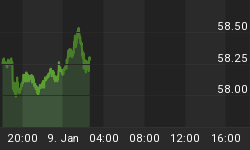Below is an extract from a commentary originally posted at www.speculative-investor.com on 12th July 2007.
In the latest Weekly Update we reiterated our view that the primary driver of the long-term bull market in commodities -- often referred to as the "commodity super cycle" -- is inflation (expansion of the money supply and consequential reduction in the value of money) and not the abnormally high real growth in countries such as China and India. We also acknowledged that Frank Veneroso's view regarding the effects of manipulation on base metal prices probably has some validity, but noted that Mr. Veneroso's willingness to use official price indices when calculating inflation-adjusted prices greatly diminished his analysis.
We've explained in previous commentaries that the whole concept of a number that purports to reflect the "general price level" is fatally flawed because it makes no sense to calculate the average of disparate things. As a result, even the most honest and rigorous attempt to calculate the average price within the economy will fail. However, those who insist on using price indices in their efforts to compare 'real' performances during different cycles should at least use consistent price-index methodology; otherwise, any conclusions they reach will be rendered meaningless by the large changes that have occurred to the way the CPI is calculated. For example, if your goal is to show how commodities have performed in CPI-adjusted terms from the 1960s through to the present day then you should, at least, use the same method of CPI calculation throughout. You should not adjust current prices using the current CPI calculation methodology and 1970s prices using the CPI calculation methodology of that era because the way the CPI is calculated today bears little resemblance to the way it was calculated in the 1970s.
With the above in mind we'll now take a look at some long-term CPI-adjusted charts.
The following charts were produced by Nick Laird of www.sharelynx.com using CPI data provided by John Williams of www.shadowstats.com (the "SS" on the charts stands for "Shadow Statistics"). They show how the Dow Industrials Index, gold and copper have performed in CPI-adjusted terms since 1969 using the CPI calculation methodology of the 1970s throughout. By applying this consistent methodology we can see that:
a) In CPI-adjusted terms the Dow's rally since its 2003 bottom has been weak. In fact, in addition to still being about 40% below its all-time high it is also lower than where it was in mid-2003.
b) Gold has made some real gains since 2001, but the gains have been small. We think this is because the high inflation of the past several years has been accompanied by only a small increase in inflation fears -- a sign that governments and central banks have done a stellar job managing inflation expectations*. Of course, one of the main ways via which expectations have been managed is the altering of the CPI calculation methodology such that the hard-working folk at the Ministry of Plenty are able to report a 2-3% increase in the general price level every year almost regardless of what is actually happening in the world. Had we not witnessed it with our own eyes we would not believe that so many 'intelligent' analysts would be prepared to ignore the evidence of their own eyes and blindly accept the official line that inflation is low.
c) Although the copper price has made substantial real gains since 2003, this cycle's gains have not been out of the ordinary.
The overarching message of these charts is that the primary driver of the global boom is inflation, not real growth. That so few people realise this explains why the monetary metal (gold) has fared poorly relative to the industrial metals, and why bond yields remain near generational lows.



In a nutshell, what we've had over the past several years has been the strange -- perhaps even unprecedented -- combination of persistently high inflation and persistently low inflation fears. As a result, most people have interpreted the price rises as 'real'. And if you believe the price rises are real, or mostly real, then you will seek out an explanation that matches this belief; hence, the popular notion that an Asian-growth-fueled "commodity super cycle" is underway or the less popular notion (the Veneroso view) that the primary driver of commodity prices has been rampant speculation bordering on manipulation. Both of these notions are based on the incorrect (in our opinion) premise that the price rises are mostly real (not the result of inflation).
*Fed Chief Bernanke underlined the importance of managing the public's inflation expectations in a speech delivered only two days ago (Tuesday 10th July) at the monetary economic workshop of the National Bureau of Economic Research. Refer to this Marketwatch.com article for further details.
















